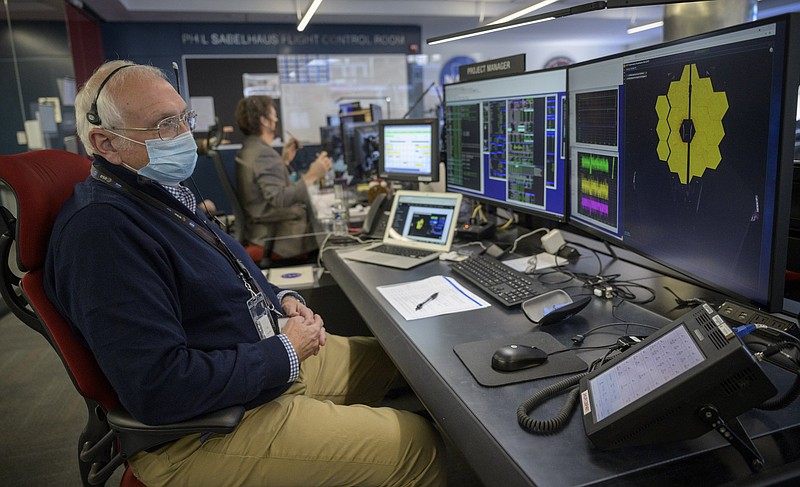Two weeks ago, the most powerful space observatory ever built roared into the sky, carrying the hopes and dreams of a generation of astronomers in a tightly wrapped package of mirrors, wires, motors, cables, latches and sheets of thin plastic.
On Saturday morning, the James Webb Space Telescope completed a crucial step by unfolding the last section of its golden, hexagonal mirrors. Nearly three hours later, engineers sent commands to latch those mirrors into place, a step that amounted to it becoming fully deployed, according to NASA.
[Video not showing up above? Click here to watch » arkansasonline.com/19webb/]
It was the latest in a series of delicate maneuvers as the observatory speeds far away into space. Now the telescope is almost ready for business, though more tense moments are still in its future.
"I'm emotional about it," Thomas Zurbuchen, NASA's science chief, said of the telescope's mirrors finally clicking into place. "What an amazing milestone -- we see that beautiful pattern out there in the sky now almost complete."
The James Webb Space Telescope, named after a former NASA administrator who oversaw the formative years of the Apollo program, is 25 years and $10 billion in the making. It is three times the size of the Hubble Space Telescope and designed to see further into the past than its celebrated predecessor in order to study the stars and galaxies that took shape at the dawn of time.
The launch on an Ariane rocket on the morning of Dec. 25 was flawless -- the engineers said it saved enough maneuvering fuel to significantly extend the mission's estimated 10-year lifetime. But the telescope must complete a month-long journey to a spot a million miles up, far beyond the moon's orbit, called L2, where gravitational fields of Earth and the sun commingle to produce the conditions for a stable orbit around the sun.
With a primary mirror 21 feet across, the observatory was too big to fit in a rocket. So the mirror was made in segments -- 18 gold-plated hexagons folded together -- that would have to pop into position once the telescope was in space.
Another challenge was that the telescope's instruments had to be sensitive to infrared or "heat radiation," a form of electromagnetic radiation invisible to the human eye. Because of the expansion of the universe, the most distant and oldest galaxies are flying away so fast that visible light from those galaxies shifts into the longer infrared wavelengths. To study those galaxies, the observatory will view the universe in colors no human eye has ever seen.
But in order to detect infrared radiation from distant sources, the telescope has to be very cold, only a few degrees above zero, so the device itself does not interfere with the work.
After years of deployment tests on Earth, small surprises in space have popped up during the deployment, or the "getting-to-know-you phase of the telescope," said Bill Ochs, an engineer at the Goddard Space Flight Center in Maryland and a project manager for the telescope.
Mission managers detected high temperatures on an onboard motor used only in the deployment process, so engineers repointed the telescope last Sunday to protect the device from the sun's heat. Then the solar arrays were readjusted when engineers noticed that the telescope had smaller power reserves than expected.
One of the most dicey moments came Tuesday, with the successful unfolding of a sunscreen the size of a tennis court. It was designed to keep the telescope in the dark and cold enough so its own heat wouldn't obscure the heat detected from distant stars. The screen is made of five layers of a plastic called Kapton, which is similar to Mylar and just as flimsy, and which had occasionally ripped during rehearsals of its deployment.
But the unfolding went flawlessly this time.
As the telescope ticked off one chore after another, the astronomers who had been waiting 25 years began to relax.
When the last mirrors locked in place, the team at mission control broke into applause and a flurry of high-fives and fist bumps.
"How does it feel to make history, everybody?" Zurbuchen asked the mission's managers in Baltimore after the latching was complete. "You just did it."
By the end of January, the telescope will be in its final orbit. The astronomers will spend the next five months tweaking the mirrors to bring them into common focus and beginning to test and calibrate their instruments.
Then real science will begin. Astronomers have said the first picture from the telescope will appear in June.
